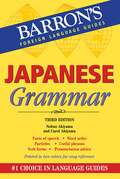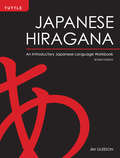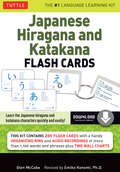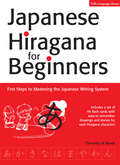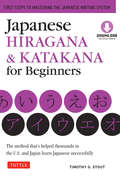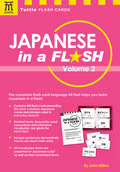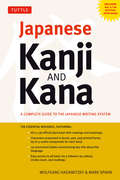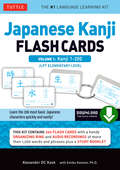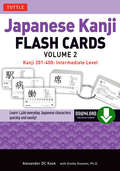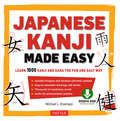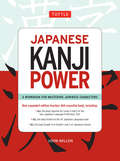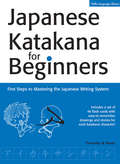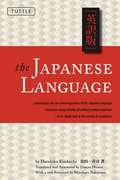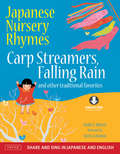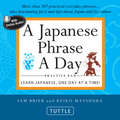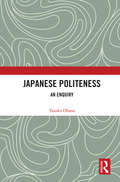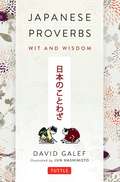- Table View
- List View
Japanese Grammar (Barron's Grammar Ser.)
by Nobuo Akiyama Carol AkiyamaA Simon & Schuster eBook. Simon & Schuster has a great book for every reader.
Japanese Hiragana
by Jim GleesonThis workbook has been carefully designed to facilitate the quick and easy mastery of the forty-six character hiragana syllabary used to write all types of native words not written in kanji.Each character is introduced here with brushed, handwritten, and typed samples to enhance character recognition. Entertaining illustrations and amusing examples of onomatopoeic usage of hiragana in Japanese writings further reinforce memorization in a fun way.This easy-to-use and practical workbook is well suited for beginning students of all ages. This revised edition has 16 more pages of exercises and additional practice pages.
Japanese Hiragana
by Jim GleesonThis workbook has been carefully designed to facilitate the quick and easy mastery of the forty-six character hiragana syllabary used to write all types of native words not written in kanji.Each character is introduced here with brushed, handwritten, and typed samples to enhance character recognition. Entertaining illustrations and amusing examples of onomatopoeic usage of hiragana in Japanese writings further reinforce memorization in a fun way.This easy-to-use and practical workbook is well suited for beginning students of all ages. This revised edition has 16 more pages of exercises and additional practice pages.
Japanese Hiragana and Katakana Flash Cards Kit
by Emiko Konomi Glen MccabeLearning to recognize and pronounce the basic hiragana and katakana phonetic alphabets is the first step in studying the Japanese language.<P><P>This set of 200 flash cards along with accompanying booklet, wall charts, and audio disc contains everything you need to quickly gain mastery of the two Japanese syllabaries and is a great way to learn Japanese. Frequent review is the key to memorizing the characters, and these cards are easily carried in a pocket or purse for a quick review session anytime.This box contains: 200 hole-punched flash cards with an organizing ring. Two 24" x 18" wall charts showing all hiragana and katakana. Native-speaker audio recordings of 1,128 words and phrases. 32-page study booklet with indexes and practice tips.Also available from Tuttle Publishing, Japanese Kanji Flash Cards Kit can be used alongside these flash cards to master written Japanese.
Japanese Hiragana for Beginners: First Steps to Mastering the Japanese Writing System
by Timothy G. StoutLearn how to write all the basic Japanese hiragana with this user-friendly workbook.<P><P>Japanese Hiragana for Beginners makes learning hiragana fast and effective by using memorable picture mnemonics, along with clear explanations, examples and lots of fun exercises-a method that has helped thousands of students learn hiragana successfully in the United States and Japan. Picture mnemonics enhance memory by associating the shape and sound of each hiragana character with combinations of images and English words already familiar to students.This Japanese language learning book is divided into three main sections: Section 1 introduces the basic 46 hiragana characters along with writing tips and practice exercises. Section 2 teaches the usage rules that allow students to write Japanese sounds. Section 3 strengthens students' skills through a wide range of exercises (word searches, crossword puzzles, fill in the blanks, visual discrimination, timed quizzes, etc).A set of flash cards printed on perforated cardstock and a list of suggested flash card activities, are also provided at the end of the book. Each of these cards introduces a hiragana character along with picture mnemonic that helps to recognize and remember it.
Japanese Hiragana & Katakana for Beginners
by Timothy G. StoutThe method that's helped thousands in the U.S. and Japan learn Japanese successfully.Japanese has two basic writing systems, hiragana and katakana, in addition to the one that uses Chinese characters or Kanji. <P><P> This handy book teaches you a new mnemonics-based method to read and write the basic 92 hiragana and katakana characters.Memorable picture mnemonics help you to learn the characters by associating their shapes and sounds with combinations of images and English words already familiar to you.Clear examples and entertaining exercises offer opportunities to read, write, use and practice all 46 basic hiragana and 46 basic katakana characters, plus the remaining kana that stand for more complex sounds.Polish your knowledge with word searches, crossword puzzles, fill-in-the-blanks, timed recognition quizzes, and other interesting activities.The Downloadable Content allows you to print out your own flash cards (featuring the same mnemonic images taught in the book) to help you review and practice, even while you're on the go.
Japanese in a Flash Volume 2
by John MillenTuttle is pleased to offer Tuttle Japanese in a Flash Volume 2, an excellent Japanese language learning resource for students of Japanese.<P><P>Consisting of a complete boxed set of Japanese flash cards for Japanese word recognition, vocabulary building, review and recall, Tuttle Japanese in a Flash Volume 2 provides a full range of features to assist beginning and intermediate learners, especially when used in conjunction with Volume 1. Contains 448 flash cards presenting the most common Japanese words and phrases used in everyday speech. Related terms, frequently-used expressions and extended vocabulary are given for each item. Sample sentences demonstrate how to use each main entry. All vocabulary items are presented in Japanese script as well as their romanized form.
Japanese Kanji and Kana
by Wolfgang Hadamitzky Mark SpahnThis is a self-study book for leaning Japanese Kanji and KanaLong the leading book for learning Japanese Characters, Japanese Kanji and Kana is the resource you need to master the basic Japanese characters (kanji) and the hiragana and katakana syllabaries (known collectively as kana).Complete, compact and essential, this is the resource you need in order to use and master kanji. This new edition reflects the recent update by the Japanese government of the official Joyo kanji list. Joyo means "daily use," and these 2,136 kanji are the ones that every Japanese person learns in public education. The kana and kanji are presented in an easy to understand format. A concise indexing section also allows the book to function as a Japanese dictionary and plenty of extra space is allowed for writing Kanji and writing Kana. All the characters are written clearly making reading kanji and reading kana effortless.This book features:All 2,136 official Joyo kanji with readings and meaningsUp to 5 useful compounds for each kanjiBrush & pen forms, too-not only printed form19 convenient tables summarizing key info about the languageEasy access to all kanji via 3 indexes: by radical, stroke count, and readings
Japanese Kanji and Kana
by Mark Spahn Wolfgang HadamitzkyThis comprehensive book helps you learn the 92 basic Kana characters and 2,136 standard Kanji characters.Complete, compact and authoritative-this book provides all the information needed to learn kanji and kana, including the 92 basic hiragana and katakana phonetic symbols (known collectively as Kana) and the 2,136 standard Joyo Kanji characters that every Japanese person learns in school.The kana and kanji are presented in an easy and systematic way that helps you learn them quickly and retain what you have learned and improve your mastery of the Japanese language-the ability to read Japanese and write Japanese is an essential skill for any student. A concise index allows you to look up the Kanji in three different ways (so the book also serves as a Japanese Kanji dictionary) and extra spaces are provided to allow you to practice writing Japanese. This book contains: All 2,136 official Joyo kanji with readings and definitions. Characters are graded by their JLPT examination levels. Up to 5 useful vocabulary compounds for each kanji. Brush and pen cursive forms as well as printed forms. 19 tables summarizing key information about the characters. Kanji look-up indexes by radicals, stroke counts and readings.
Japanese Kanji and Kana
by Mark Spahn Wolfgang HadamitzkyThis comprehensive book helps you learn the 92 basic Kana characters and 2,136 standard Kanji characters.Complete, compact and authoritative--this book provides all the information needed to learn the Japanese writing system, including the 92 basic hiragana and katakana phonetic symbols (known collectively as Kana) and the 2,136 standard Joyo Kanji characters that every Japanese person learns in school.The kana and kanji are presented in an easy and systematic way that helps you learn them quickly and retain what you have learned and improve your mastery of the Japanese language--the ability to read Japanese and write Japanese is an essential skill for any student. A concise index allows you to look up the Kanji in three different ways (so the book also serves as a Japanese Kanji dictionary) and extra spaces are provided to allow you to practice writing Japanese. This book contains: All 2,136 official Joyo kanji with readings and definitions. Characters are graded by their JLPT examination levels. Up to 5 useful vocabulary compounds for each kanji. Brush and pen cursive forms as well as printed forms. 19 tables summarizing key information about the characters. Kanji look-up indexes by radicals, stroke counts and readings.
Japanese Kanji Flash Cards, Volume 1
by Alexander Kask Emiko KonomiEverything you need to learn the 200 basic Japanese kanji characters is here in this ebook!Flash cards are an essential tool in memorizing words when you are learning a new language. In Japanese Kanji Flash Cards, Volume 1, you'll get all the tools needed to learn the basic 200 Japanese kanji, including: 200 flash cards featuring the most commonly-used characters. Downloadable audio recordings of over 1,200 words and phrases from a native speaker. A 32-page study booklet with sorting indexes and practice tips.Each expertly-designed Japanese flash card in this ebook offers core information about the meanings, pronunciations, vocabulary and usage for each character along with memorable phrases and drawings to help you learn the Kanji. A stroke-order diagram shows how to write the Kanji correctly. Plus, the cards allow you to sort into smaller sets so you can learn or review them in batches and help to remember the kanji character effectively. This ebook covers the first half of all characters needed for the Japanese AP exam, and all N5 Level and many N4 Level kanji required to pass the standard Japanese Language Proficiency Test or JLPT.Watch your ability to learn kanji, read kanji, write kanji, and remember kanji grow steadily each day with Japanese Kanji Flash Cards, Volume 1!
Japanese Kanji Flash Cards Volume 2: Intermediate Level (Downloadable Material Included)
by Emiko Konomi Alexander KaskEverything you need to learn 200 everyday Japanese kanji characters is here in this ebook!Flash cards are an essential tool in memorizing words when you are learning a new language. In Japanese Kanji Flash Cards Kit, Volume 2, you'll get all the tools needed to learn 200 everyday Japanese kanji, following on from the 200 kanji introduced in Volume 1 of this series.This Japanese language ebook includes: 200 flash cards featuring commonly used characters. Downloadable audio recordings of over 1,200 words and phrases from a native speaker. A 32-page study booklet with sorting indexes and practice tips. Each expertly designed flash card in this ebook offers core information about the meanings, pronunciations, vocabulary, and usage for each character along with memorable phrases and drawings to help you learn the kanji. A stroke-order diagram shows how to write the kanji correctly. You can also sort the cards into smaller sets so you can learn or review them in batches and help to remember the kanji character effectively.
Japanese Kanji Made Easy: Learn 1,000 Kanji and Kana the Fun and Easy Way
by Michael L. KluemperMake character memorization a breeze with Japanese Kanji Made Easy! <P><P> Learning the fundamental kanji characters used to write Japanese can be challenging, but this book is designed to speed up learning by presenting the 1,000 most common characters using a mnemonic approach. In a fun and accessible way to learn Japanese, each kanji is associated with memorable visual and verbal clues. For example, the Japanese character for person is superimposed over a sketch of a smiling man. The visual clue is "a person standing on two legs". By seeing the distinctive shape of the kanji, learners create a mental image of its meaning.As well, each character is presented as part of a group of characters which share similar traits. These groups use common root symbols known as radicals; they are also categorized by themes such as colors, numbers, animals, or body parts. Pronunciations, meanings and common vocabulary compounds are provided for each character in the group. Mnemonic clues are also given for the basic 92 hiragana and katakana phonetic symbols. Downloadable audio helps you learn pronunciation for all of the characters and vocabulary in this book. The short introduction explains the basic history and structure of the kanji.Key feature of this Japanese kanji book include: Hiragana and katakana phonetic symbols Easy-to-remember drawings and stories for ALL characters Thousands of vocabulary words Downloadable audio for pronunciation practiceA highly visual book, Japanese Kanji Made Easy is a powerful learning tool for both the serious student of the Japanese language, and those simply curious about kanji.
Japanese Kanji Power
by John MillenJapanese Kanji Power is a workbook for mastering Japanese characters (Kanji) with the added power of a dictionary.This resource is essential for the serious student looking to get an A in Kanji class or the language enthusiast ready to take written Japanese to the next level. This new expanded edition teaches all 464 essential Kanji required for Levels 4 and 5 of the new Japanese Language Proficiency Test and the AP Japanese Language exam. Each Kanji is presented with the information needed to learn and remember the character and its many variations and uses. Cumulative exercises allow students to practice the Kanji and strengthen existing knowledge. An indexing feature allows Japanese Kanji Power to function as a Kanji dictionary.The presentation of each Kanji incorporates a number of key features, including:Several example sentences that introduce each kanji reading in contextA list of frequently-used compounds and phrases that allows you to increase your practical vocabularyBackground information, such as the original of the character of a mnemonic to aid in memorizationStroke count and a stroke-order diagramWriting hints and a writing practice gridNumerous exercises and frequent reviews for reinforcement
Japanese Katakana for Beginners First Steps to Mastering the Japanese Writing System (Tuttle Language Library)
by Timothy G. StoutThis is a user-friendly guide to learning Japanese Katakana and includes a set of 46 flash cardsJapanese Katakana for Beginners makes learning of katakana fast and effective by using memorable picture mnemonics, along with clear explanations, examples and lots of fun exercises, a method that has helped thousands of students lean katakana successfully in the United States and Japan. <P><P>Picture mnemonics enhance memory by associating the shape and sound f each katakana character with combinations of images and English words already familiar to students. This book is organized into three main sections:The first introduces the basic 46 katakana characters along with writing tips and opportunities to practice writing them.The secondteachers the usage rules that allow students to write all Japanese sounds, providing more opportunities for practice.The third strengthens students' skills through a wide range of exercises (word searches, crossword puzzles, fill in the blanks, visual discrimination, timed recognition quizzes, etc) designed to both increase the knowledge of the Japanese language and reinforce newly acquired writing skillsA set of flash cards printed on perforated cardstock and a list of suggested flash card activities, are also provided at the end of the book. Each of these cards introduces a katakana character along with the picture mnemonic that helps to recognize and remember it.
The Japanese Language
by Umeyo Hirano Haruhiko Kindaichi Mineharu NakayamaThis is a book about the structure, history and evolution of the Japanese languageThe Japanese Language is a classic study of one of the world's most widely used but least understood languages. Emphasizing the richness and complexity of Japanese as well as its limitations, this fine book provides a lively discussion about the uniqueness of the Japanese language.This book will interest anyone intrigued by one of the word's most widely used and least understood languages. The relationship of Japanese to other languages is not well understood even by native speakers, and Proffessor Kindaichi sets out to define it. He concludes that Japanese is indeed only remotely related to other world languages although it shares many features in common with the languages of mainland AsiaReaders who are just beginning Japanese study will find this section especially fascinating, for each point is backed by examples from literature and everyday speech. Kindaichi also investigates the so-called vagueness of Japanese and traces it to its source-the unusual sentence order. This book includes:The highly debated origins of the Japanese languageDialects, jargon, sex- and role-based distinctionsDifferences between informal, formal, and literary langaugeStructure, rhythm, and accent of pronunciationWhat can and cannot be said in Japanese
The Japanese Language
by Haruhiko Kindaichi Umeyo Hirano Mineharu NakayamaThis is a book about the structure, history and evolution of the Japanese languageThe Japanese Language is a classic study of one of the world's most widely used but least understood languages. Emphasizing the richness and complexity of Japanese as well as its limitations, this fine book provides a lively discussion about the uniqueness of the Japanese language.This book will interest anyone intrigued by one of the word's most widely used and least understood languages. The relationship of Japanese to other languages is not well understood even by native speakers, and Proffessor Kindaichi sets out to define it. He concludes that Japanese is indeed only remotely related to other world languages although it shares many features in common with the languages of mainland AsiaReaders who are just beginning Japanese study will find this section especially fascinating, for each point is backed by examples from literature and everyday speech. Kindaichi also investigates the so-called vagueness of Japanese and traces it to its source-the unusual sentence order. This book includes:The highly debated origins of the Japanese languageDialects, jargon, sex- and role-based distinctionsDifferences between informal, formal, and literary langaugeStructure, rhythm, and accent of pronunciationWhat can and cannot be said in Japanese
Japanese Made Easy
by Tazuko Ajiro MonaneThis is a basic, do#150;it#150; yourself guide to the Japanese language Harvard University's Tazuko Monane teaches you the secret of speaking Japanese fluently in simple 20-minute lessons. Each lesson zeroes in on one everyday activity: introducing yourself, asking directions, ordering sushi, giving directions to a taxi driver, eating with friends, and other everyday conversations. Japanese Made Easy is designed for people living in or going to Japan who have never studied Japanese before. Obviously, living or traveling in Japan is itself not the secret to learning Japanese#151;many Westerners live in Japan for a long time and except for a few words learn very little about its language. The important thing will be your motivation to learn. Whether you travel to Japan as a tourist, student or businessperson, whether you use this book before or after your arrival in Japan, what could provide better motivation than knowing that a familiarity with the Japanese language (and with the culture it reflects) will help make your stay in Japan much richer and more interesting. If you have the good fortune to know a Japanese person, he or she will surely make your learning even easier#151;especially when you study pronunciation. But don't be discourage if you have no "live model" to learn from. By following the simple suggestions given here, you will be able to come out with good understandable Japanese on your own. Key features of this book include: More than 40 social situations commonly encountered by foreigners in Japan#151;including greetings, asking directions, dining out, visiting places, and shopping. Practice exercises based on over 30 of the most important Japanese sentence patterns, with example sentences and answer keys. Notes on the key points of Japanese vocabulary and Japanese grammar. A comprehensive glossary of important Japanese words and an index of vocabulary and grammar items.
Japanese Nursery Rhymes
by Danielle Wright Helen Acraman2012 Creative Child Magazine Media of the Year Award Winner!What better way to learn a new language than through rhymes and music?Everywhere in the world, there are poems and songs especially for children--rhymes that are sung from generation to generation and never forgotten. In Japan, nursery rhymes speak of nature, of everyday joys and of Japan's own special culture. In Japanese Nursery Rhymes fifteen well-loved verses are colorfully presented in a format that makes language learning easier. The included audio CD features kids singing in both Japanese and English--songs so lively and sweet you'll find yourself singing along!For preschoolers and beyond, this book will be a joy to the mind, the eye, the ear and the heart.
Japanese Nursery Rhymes: Carp Streamers, Falling Rain and Other Traditional Favorites (Share and Sing in Japanese & English; includes Downloadable Audio)
by Danielle Wright Helen Acraman**2012 Creative Child Magazine Media of the Year Award Winner!**A delightful collection of fifteen well-loved rhymes, Japanese Nursery Rhymes is the perfect introduction to Japanese language and culture for young readers.What better way to learn the Japanese language than through rhymes and music. This beautifully illustrated multicultural book features songs and rhymes in both English and Japanese. Accompanied by an audio CD with recordings of kids singing in both languages - songs so fun and charming, it will be nearly impossible for you not to sing along!Favorite Japanese songs and rhymes include: My Hometown Bubbles The Rabbit Dance The Cradle Lullaby and many more!For preschoolers and beyond, this book will be a joy to the mind, the eye, the ear and the heart.
A Japanese Phrase A Day Practice Pad: Learn Japanese, One Day at a Time!
by Sam Brier Keiko MatsuuraThis page-a-day Japanese language pad teaches a new Japanese phrase each day-useful vocabulary that comes in handy for everyday situations when visiting Japan.<P><P>Although more people are studying the Japanese language than ever before, others are still wary of starting because they believe, "it's too difficult." But A Japanese Phrase A Day will show absolute beginners that Japanese is in many ways much easier than other languages and it will help intermediate Japanese learners review and improve upon their past studies and practice Japanese everyday. Japanese is a fascinating language that uses Chinese characters (kanji) as well as two other alphabets (hiragana and katakana). After a few weeks of gradual progress your ability to read Japanese, write Japanese and speak Japanese will grow tremendously.This calendar like desk companion is divided into monthly topics and builds upon itself, one day at a time. Japanese phrases are kept short, simple and functional. Each of the 365 pages include these four components:The phrase or dialogue in Japanese charactersA transliteration using English letters (romanji), which gives English speakers a guide to pronunciationThe English translationA related note about the phrase, Japan, or Japanese culture to add context.Audio for all of the Japanese Phrase A Day entries is available online. Listening and repeating after the native speakers in the audio files will help you to practice Japanese regularly and polish your spoken Japanese and Japanese listening comprehension. To get started, turn to Day One and begin studying the phrase, its meaning, pronunciation and cultural context. Then tear off the sheet and practice writing it a few times. In a matter of days you'll be on your way to reading and writing Japanese!
Japanese Politeness: An Enquiry
by Yasuko ObanaAlthough Japanese language is one of the most quoted examples in politeness research, extant publications focus on particular areas of politeness, and very few of them enquire into varied aspects of Japanese politeness. In this book, Yasuko Obana provides an integrated account of what signifies Japanese politeness. By examining how far previous assumptions can apply to Japanese, Obana exposes a variety of characteristics of Japanese politeness. By taking a diachronic approach, she probes into what constitutes politeness, extracts key elements of the term ‘polite’ in Japanese, and demonstrates how modern honorifics’ apparent diverse, divergent uses and effects can be integrated into a systematic matrix. Furthermore, by quoting traditional Japanese language scholars’ (kokugo gakusha) studies, Obana brings different views into the open. She also carves out politeness strategies in Japanese that have not been adequately explored to date. They often conform to the way in which honorifics behave because they often reflect social indexicality. This book is a good reference for scholars in pragmatics, particularly for those who are working on politeness. It is useful for Japanese language teachers who want to know how to teach Japanese politeness to non-native learners. Postgraduate students of Japanese or pragmatics will also find this book useful as a self-study book.
Japanese Proverbs
by David Galef Jun Hashimoto"Destroy a nation, but its mountains and rivers remain."--Japanese proverbThis is a collection of 200 Japanese proverbs with illustrations and explanations for each saying.Go beyond speaking Japanese-peek into the soul of Japan. Japanese Proverbs: Wit and Wisdom is a delightfully illustrated compilation of traditional Japanese proverbs and sayings. Some of the classic Japanese quotes and quotations, like "Fall down seven times, get up eight", capture the dogged perseverance of the Japanese heart. Others, such as "A red lacquer dish needs no decoration" illuminate both a universal truth and Japan's unique, aesthetic traditions. Japanese Proverbs: Wit and Wisdom has proverbs of great cultural significance as well as proverbs on matters of daily life and customs.Pleasing to expert and new-comer alike, the 200 traditional proverbs in this unique collection are presented in Japanese script (kana and kanji) and romanized (romaji) form, along with direct English translations. Similar proverbs are given from English, and the sumi-e style ink drawings are a delight in their own right.You'll speak Japanese with the verve and nuance of a native when you use these apt and witty expressions.
Japanese Proverbs
by Jun Hashimoto David Galef"Destroy a nation, but its mountains and rivers remain."--Japanese proverbThis is a collection of 200 Japanese proverbs with illustrations and explanations for each saying.Go beyond speaking Japanese-peek into the soul of Japan. Japanese Proverbs: Wit and Wisdom is a delightfully illustrated compilation of traditional Japanese proverbs and sayings. Some of the classic Japanese quotes and quotations, like "Fall down seven times, get up eight", capture the dogged perseverance of the Japanese heart. Others, such as "A red lacquer dish needs no decoration" illuminate both a universal truth and Japan's unique, aesthetic traditions. Japanese Proverbs: Wit and Wisdom has proverbs of great cultural significance as well as proverbs on matters of daily life and customs.Pleasing to expert and new-comer alike, the 200 traditional proverbs in this unique collection are presented in Japanese script (kana and kanji) and romanized (romaji) form, along with direct English translations. Similar proverbs are given from English, and the sumi-e style ink drawings are a delight in their own right.You'll speak Japanese with the verve and nuance of a native when you use these apt and witty expressions.
Japanese Proverbs
by Jun Hashimoto David Galef"Destroy a nation, but its mountains and rivers remain."--Japanese proverbThis is a collection of 200 Japanese proverbs with illustrations and explanations for each saying.Go beyond speaking Japanese-peek into the soul of Japan. Japanese Proverbs: Wit and Wisdom is a delightfully illustrated compilation of traditional Japanese proverbs and sayings. Some of the classic Japanese quotes and quotations, like "Fall down seven times, get up eight", capture the dogged perseverance of the Japanese heart. Others, such as "A red lacquer dish needs no decoration" illuminate both a universal truth and Japan's unique, aesthetic traditions. Japanese Proverbs: Wit and Wisdom has proverbs of great cultural significance as well as proverbs on matters of daily life and customs.Pleasing to expert and new-comer alike, the 200 traditional proverbs in this unique collection are presented in Japanese script (kana and kanji) and romanized (romaji) form, along with direct English translations. Similar proverbs are given from English, and the sumi-e style ink drawings are a delight in their own right.You'll speak Japanese with the verve and nuance of a native when you use these apt and witty expressions.
